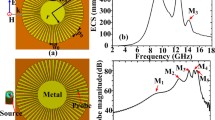Abstract
A compact plasmonic coupled-resonator system, consisting of a stub resonator and baffles in the metal–insulator–metal waveguide, is numerically investigated with the finite element method. Simulations show that sharp and asymmetric response line-shapes can occur in the system. The asymmetric line-shapes in the transmission spectra depend on the relative positions of the resonant wavelengths between the single-stub resonator and the inner resonator constructed by the baffle and the stub resonator, while the other part of the transmission spectra (except the asymmetric part) maintains the spectral features of the structure constructed by the baffles. An analytic model and a relative phase analysis based on the scattering matrix theory are used to describe and explain this phenomenon. These sharp and asymmetric response line-shapes are important for improving the nano-plasmonic devices’ performances.




Similar content being viewed by others
References
Barnes WL, Dereux A, Ebbesen TW (2003) Surface plasmon subwavelength optics. Nat 424:824–830
Gramotnev DK, Bozhevolnyi SI (2010) Plasmonics beyond the diffraction limit. Nat Photon 4:83–91
Chen JJ, Li Z, Yue S, Xiao JH, Gong QH (2012) Plasmon-induced transparency in asymmetric T-shape single slit. Nano Lett 12:2494–2498
Economou EN (1969) Surface plasmons in thin films. Phys Rev 182(2):539–554
Veronis G, Fan S (2005) Bends and splitters in metal–dielectric–metal subwavelength plasmonic waveguides. Appl Phys Lett 87:131102
Dionne JA, Lezec HJ, Atwater HA (2006) Highly confined photon transport in subwavelength metallic slot waveguides. Nano Lett 6(9):1928–1932
Lezec HJ, Dionne JA, Atwater HA (2007) Negative refraction at visible frequencies. Science 316(5823):430–432
Neutens P, Dorpe PV, Vlaminck LD, Lagae L, Borghs G (2009) Electrical detection of confined gap plasmons in metal–insulator–metal waveguides. Nat Photon 3:283–286
Walters RJ, van Loon RVA, Brunets I, Schmitz J, Polman A (2010) A silicon-based electrical source of surface plasmon polaritons. Nat Mater 9:21–25
Lin XS, Huang XG (2008) Tooth-shaped plasmonic waveguide filters with nanometeric sizes. Opt Lett 33:2874–2876
Matsuzaki Y, Okamoto T, Haraguchi M, Fukui M, Nakagaki M (2008) Characteristics of gap plasmon waveguide with stub structures. Opt Express 16(21):16314–16325
Lu H, Liu XM, Mao D, Wang LR, Gong YK (2010) Tunable band-pass plasmonic waveguide filters with nanodisk resonators. Opt Express 18(17):17922–17927
Wang TB, Wen XW, Yin CP, Wang HZ (2009) The transmission characteristics of surface plasmon polaritons in ring resonator. Opt Express 17:24096–24101
Guo Y, Yan L, Pan W, Luo B, Wen K, Guo Z, Li H, Luo X (2011) A plasmonic splitter based on slot cavity. Opt Express 19(15):13831–13838
Hu F, Yi H, Zhou Z (2011) Wavelength demultiplexing structure based on arrayed plasmonic slot cavities. Opt Lett 36:1500–1502
Noual A, Akjouj A, Pennec Y, Gillet J-N, Djafari-Rouhani B (2009) Modeling of two-dimensional nanoscale Y-bent plasmonic waveguides with cavities for demultiplexing of the telecommunication wavelengths. N J Phys 11:103020
Tao J, Huang XG, Zhu JH (2010) A wavelength demultiplexing structure based on metal–dielectric–metal plasmonic nano-capillary resonators. Opt Express 18(11):11111–11116
Chen JJ, Li Z, Li J, Gong QH (2011) Compact and high-resolution plasmonic wavelength demultiplexers based on Fano interference. Opt Express 19:9976–9985
Fano U (1961) Effects of configuration interaction on intensities and phase shifts. Phys Rev 124(6):1866–1878
Johnson PB, Christy RW (1972) Optical constants of the noble metals. Phys Rev B 6:4370–4379
Kekatpure RD, Barnard ES, Cai W, Brongersma ML (2010) Phase-coupled plasmon induced transparency. Phys Rev Lett 104(24):243902
Fan S (2002) Sharp asymmetric line shapes in side-coupled waveguide-cavity systems. Appl Phys Lett 80:908–910
Xu Y, Li Y, Lee RK, Yariv A (2000) Scattering-theory analysis of waveguide-resonator coupling. Phys Rev E 62:7389
Haus HA, Lai Y (1991) Narrow-band distributed feedback reflector design. J Lightwave Technol 9:754
Haus HA (1984) Waves and fields in optoelectronics. Prentice Hall, New York
Acknowledgments
This work was supported by the National Natural Science Foundation of China (grant nos. 11204018, 61177085, 60937003, 51172030, 11134001, and 90921008) and the National Basic Research Program of China (grant nos. 2010CB923200, 2009CB930504, and 2013CB328704).
Author information
Authors and Affiliations
Corresponding author
Rights and permissions
About this article
Cite this article
Chen, J., Li, Z., Zhang, R. et al. Response Line-Shapes in Compact Coupled Plasmonic Resonator Systems. Plasmonics 8, 1129–1134 (2013). https://doi.org/10.1007/s11468-013-9520-3
Received:
Accepted:
Published:
Issue Date:
DOI: https://doi.org/10.1007/s11468-013-9520-3




